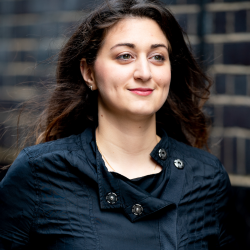
Dr Astra Papachristodoulou
About
Biography
Dr Astra Papachristodoulou holds a PhD in Creative Writing from the University of Surrey. Her practice-based doctoral project at Surrey was funded by the Doctoral College Studentship Award and explored sculptural poetics as a revolutionary act in the context of the Anthropocene. She is a widely published author with work featured in UK and international magazines including The Times, Magma Poetry and BeeCraft. Astra is the author of several books including Stargazing (Guillemot Press), and her work has been translated into Turkish, Korean, German, Russian, Slovenian and Spanish. She won the Pebeo Mixed Media Art Prize in 2016, and her visual poetry work has been showcased at venues such as the National Poetry Library, Kew Gardens and Christie's, London.
My qualifications
ResearchResearch interests
Experimental and Innovative Poetry; Feminist writing; Ecopoetry; Visual and Object Poetry; Sculptural Poetics; Exploring the sensorial dimension in poetry.
Research interests
Experimental and Innovative Poetry; Feminist writing; Ecopoetry; Visual and Object Poetry; Sculptural Poetics; Exploring the sensorial dimension in poetry.
Teaching
I teach seminars in the School of Literature and Languages. I have taught on various modules including Introduction to Creative Writing (ELI1026), The American Century (ELI2036) and Thinking Like a Writer (ELI1027).
Astra has also led visual poetry workshops for all ages in schools, universities and libraries at institutions such as the National Poetry Library, City & Guilds of London Art School, the University of Stuttgart and Liskeard Hillfort Primary School amongst many others.
Publications
Highlights
Papachristodoulou Astra (2023), Social Textiles: Poetry as Protest in the Anthropocene, Axon Journal, vol 13.1
Papachristodoulou Astra (2023), Selected Variations for Bees (Cornwall: Guillemot Press)
Papachristodoulou Astra (2022), Constellations (Cornwall: Guillemot Press)
Papachristodoulou Astra (2021), Inside Ocean Größt's Time Capsule (Shropshire: Penteract Press)
Papachristodoulou Astra (2021), Bunnies Behind Bars, co-written with John Kilburn (Newton-le-Willows: KFS Press)
Papachristodoulou Astra (2021), Auditioning for Poem Atlas, co-written with John Kilburn (London: Poem Atlas)
Papachristodoulou Astra (2020), Astropolis (Bristol: Hesteglock Press)
Papachristodoulou Astra (2019), Stargazing (Cornwall: Guillemot Press)